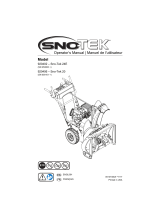
EN - 6
Before cleaning, removing clogs or making
any inspections, repairs, etc., disengage
clutch(es), stop engine, remove key, allow
moving parts to stop and hot parts to cool.
Check shear bolts and other bolts at
frequent intervals for proper tightness to be
sure the equipment is in safe working
condition.
Check clutch and brake operation
frequently.
Do not change engine governor settings and
do not over-speed engine.
Adjust and service as required. Motion of
drive wheels and auger / impeller must stop
quickly when clutch levers are released.
Always maintain unit in safe operating
condition. Damaged or worn out muffler can
cause fire or explosion.
Keep unit free of ice or other debris. Clean
up oil or fuel spills.
Always keep protective structures, guards,
and panels in good repair and secured in
place. Never modify or remove safety
devices.
Never store the machine with fuel in the fuel
tank inside a building where ignition sources
are present such as hot water heaters,
space heaters or clothes dryers. Close fuel
valve and allow the engine to cool
completely before storing in any enclosure
or covering the unit.
Always refer to operator's manual for
important details if the snow thrower is to be
stored for an extended period.
Maintain or replace safety and instruction
labels as necessary.
Run the machine a few minutes after
throwing snow to prevent freeze-up of the
auger / impeller.
Personal Protection
Do not operate the equipment without
wearing adequate winter garments. Avoid
loose fitting clothing that can get caught in
moving parts. Wear footwear that will
improve footing on slippery surfaces.
Wear adequate safety gear, including safety
glasses with side shields and protective
gloves.
Do not wear loose clothing or jewelry, and tie
back hair that may get caught in rotating
parts.
NEVER attempt to unclog or clean unit while
engine is running. Rotating auger / impeller
can cause serious injury.
Protect eyes, face and head from objects
that may be thrown from unit. Wear
appropriate hearing protection.
Always wear safety glasses or eye shields
during operation or while performing an
adjustment or repair to protect eyes from
foreign objects that may be thrown from the
machine.
Slope Operation
Exercise extreme caution when operating on
slopes. DO NOT operate on steep slopes.
DO NOT clear snow across the face of
slopes; go up and down. Keep all movement
on slopes slow and gradual.
Use a slow speed to avoid stops or shifts on
slopes. Avoid starting or stopping on a
slope. Do not park unit on a slope unless
absolutely necessary. When parking on a
slope always block the wheels.
Do not operate near drop-offs, ditches, or
embankments. Unit can suddenly turn over if
a wheel is over the edge of a cliff or ditch, or
if an edge caves in.
Fuel
DO NOT run engine in an enclosed area.
Always provide good ventilation. Fumes
from engine exhaust can cause injury or
death.
Fuel is highly flammable and its vapors are
explosive. Handle with care. Use only an
approved gasoline container with an
appropriately-sized dispensing spout.
No smoking, no sparks, no flames. Always
allow engine to cool before servicing.
Never fill fuel tank when engine is running or
hot from operation.
Never fill or drain fuel tank indoors.
Replace fuel cap securely and clean up
spilled fuel.
Never fill fuel containers inside a vehicle or
on a truck or trailer bed with a plastic liner.
Always place containers on the ground away
from your vehicle before filling.
When practical, remove gas-powered
equipment from the truck or trailer and refuel
it on the ground. If this is not possible, then
refuel on a trailer with a portable container,
rather than from a gasoline dispenser
nozzle.





















